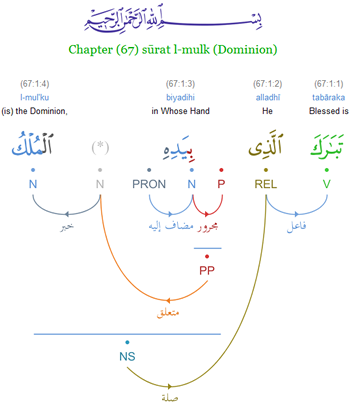Quranic Arabic Corpus
| Quranic Arabic Corpus | |
|---|---|
| Research center: | University of Leeds |
| Initial release: | November 2009 |
| Language: | Quranic Arabic, English |
| Annotation: | Syntax, morphology |
| Framework: | Dependency grammar |
| License: | GNU General Public License |
| Website: | http://corpus.quran.com/ |

The Quranic Arabic Corpus is an annotated linguistic resource consisting of 77,430 words of Quranic Arabic. The project aims to provide morphological and syntactic annotations for researchers wanting to study the language of the Quran.[1][2]Cite error: A <ref> tag is missing the closing </ref> (see the help page).:
- A manually verified part-of-speech tagged Quranic Arabic corpus.
- An annotated treebank of Quranic Arabic.
- A novel visualization of traditional Arabic grammar through dependency graphs.
- Morphological search for the Quran.
- A machine-readable morphological lexicon of Quranic words into English.
- A part-of-speech concordance for Quranic Arabic organized by lemma.
- An online message board for community volunteer annotation.
Corpus annotation assigns a part-of-speech tag and morphological features to each word. For example, annotation involves deciding whether a word is a noun or a verb, and if it is inflected for masculine or feminine. The first stage of the project involved automatic part-of-speech tagging by applying Arabic language computing technology to the text. The annotation for each of the 77,430 words in the Quran was then reviewed in stages by two annotators, and improvements are still ongoing to further improve accuracy.
Linguistic research for the Quran that uses the annotated corpus includes training Hidden Markov model part-of-speech taggers for Arabic,[3] automatic categorization of Quranic chapters,[4] and prosodic analysis of the text.[5]
See also
References
- ^ K. Dukes, E. Atwell and N. Habash (2011). Supervised Collaboration for Syntactic Annotation of Quranic Arabic. Language Resources and Evaluation Journal (LREJ). Special Issue on Collaboratively Constructed Language Resources.
- ^ K. Dukes and T. Buckwalter (2010). A Dependency Treebank of the Quran using Traditional Arabic Grammar. In Proceedings of the 7th International Conference on Informatics and Systems (INFOS). Cairo, Egypt.
- ^ M. Albared, N. Omar and M. Ab Aziz (2011). Developing a Competitive HMM Arabic POS Tagger using Small Training Corpora. Intelligent Information and Database Systems. Springer Berlin, Heidelberg.
- ^ A. M. Sharaf and E. Atwell (2011). Automatic Categorization of the Quranic Chapters. 7th International Computing Conference in Arabic (ICCA11). Riyadh, Saudia Arabia.
- ^ C. Brierley, M. Sawalha and E. Atwell (2012). Boundary Annotated Qur'an Corpus for Arabic Phrase Break Prediction. IVACS Annual Symposium. Cambridge.
